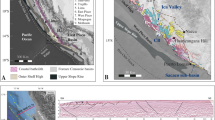Abstract
The Korea (Tsushima) Strait is an important seaway through which the warm Tsushima Current flows into the East Sea (Japan Sea). A paleogeographic map constrained by a regional sea-level curve developed on the basis of a number of recent 14C radiocarbon dates suggests that the Korea Strait was not closed during the last glacial period. Rather, it was open as a channel-like seaway linking the western North Pacific and the East Sea. Some fraction of the paleo-Tsushima Current inflow presumably continued at that time through the Korea Strait. The activity of the paleo-Tsushima Current is evidenced by the distribution pattern of river-derived lowstand deposits, consisting of a beach/shoreface complex and lowstand deltaic wedges.
Similar content being viewed by others
Author information
Authors and Affiliations
Additional information
Received: 16 April 1999 / Revision accepted: 25 February 2000
Rights and permissions
About this article
Cite this article
Park, SC., Yoo, DG., Lee, CW. et al. Last glacial sea-level changes and paleogeography of the Korea (Tsushima) Strait. Geo-Marine Letters 20, 64–71 (2000). https://doi.org/10.1007/s003670000039
Issue Date:
DOI: https://doi.org/10.1007/s003670000039




